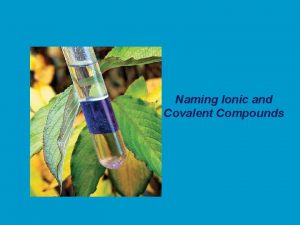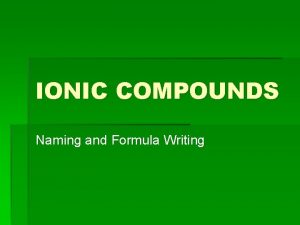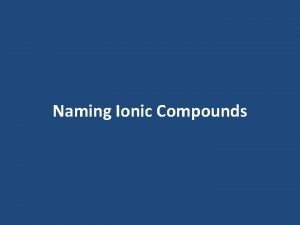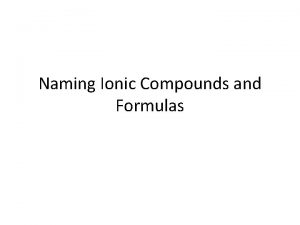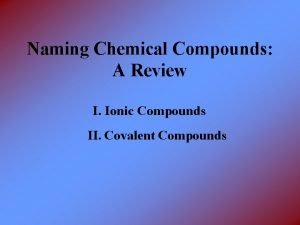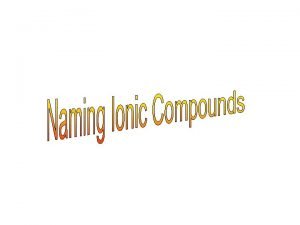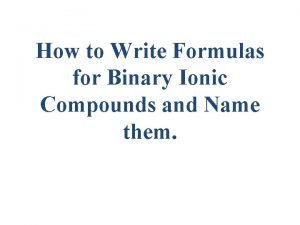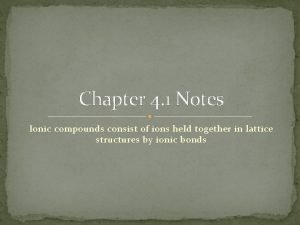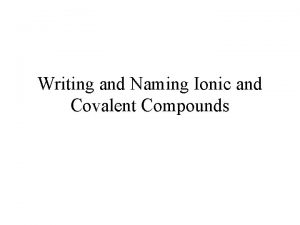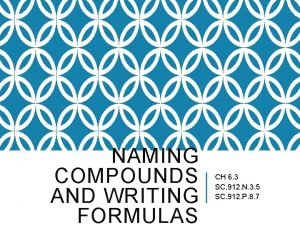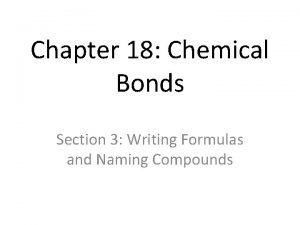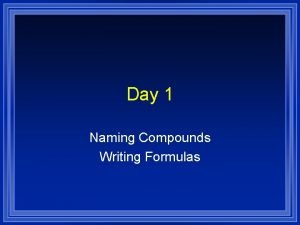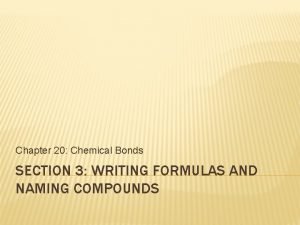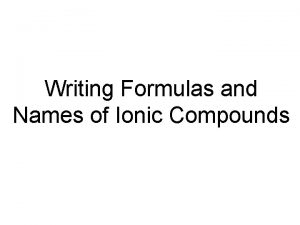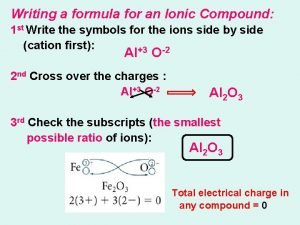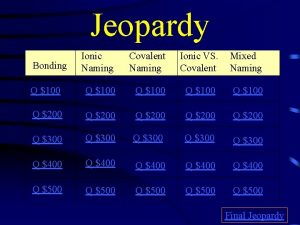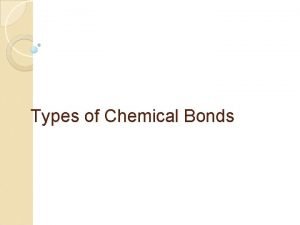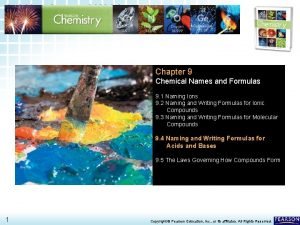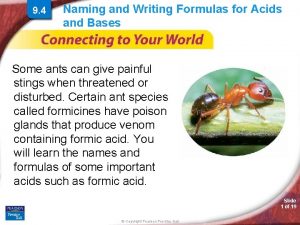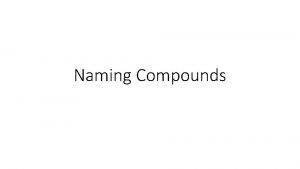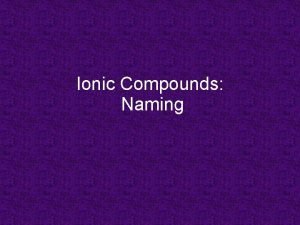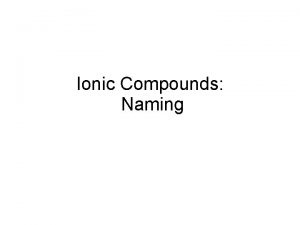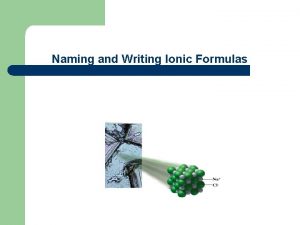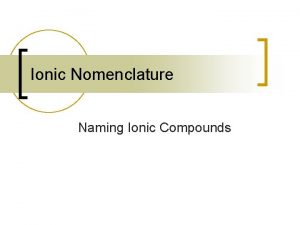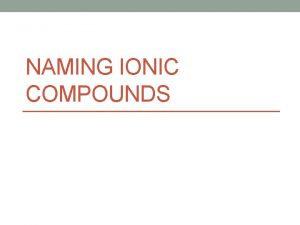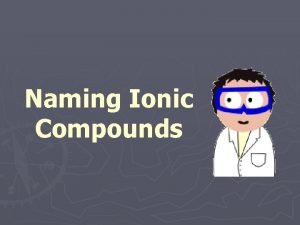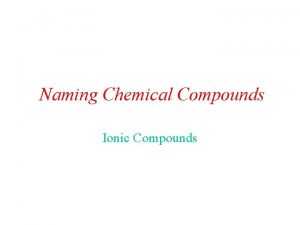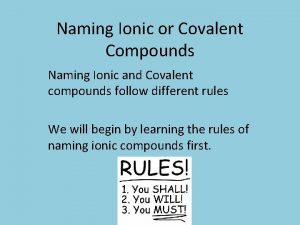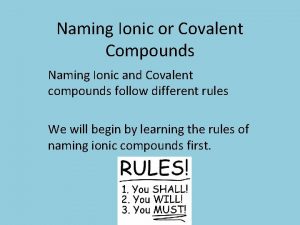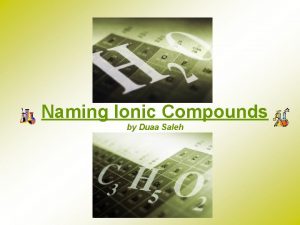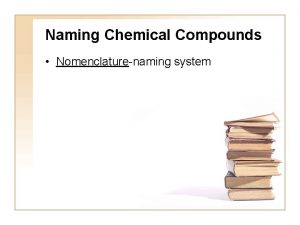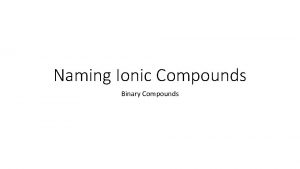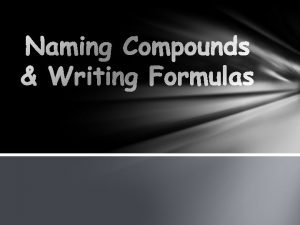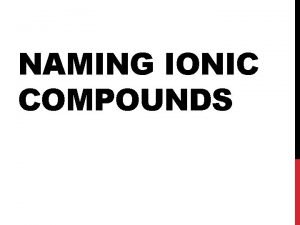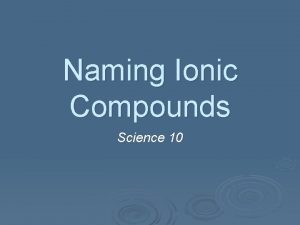Naming and Writing Ionic Compounds Ionic Compounds Occur




























- Slides: 28

Naming and Writing Ionic Compounds

Ionic Compounds • Occur between a metal and non-metal • Occur when electrons are transferred between atoms forming ions • Metals make cations = positive ions • Nonmetals make anions = negative ions • Also use these rules when a polyatomic ion is present

Ionic Bonding Using Lewis Dots In ionic bonding, electrons are transferred • K+F • Mg + I • Al + Br • • Be + S Na + O Na + Cl Ca + Cl

Do you see a pattern K+1 + F-1 Mg+2 + I-1 Al+3 + Br-1 KF Mg. I 2 Al. Br 3

Use the pattern to write these formulas: Ca + P Na + O Li + S

Writing Ionic Compounds

Guide to Writing Formulas from the Name Copyright © 2005 by Pearson Education, Inc. Publishing as Benjamin Cummings 7

1. Identify the Ions • Look at the group they are in on the periodic table • Determine the type of ion created and assign an oxidation number (charge) Be Group 2 2 electrons Be+2 Br Group 7 7 electrons Br-

2. Criss-Cross Charges • Drop Signs • Do not write any “ 1’s” Be+2 Br. Be 1 Br 2 Be. Br 2

3. Reduce/Simplify • Reduce any subscripts to the simplest form or simplest ratio. • Li. Br 2 is already simplified • But copper(II) oxide needs to be reduced since 2: 2 atoms is the same as 1: 1. +2 Cu -2 O Cu 2 O 2 Cu. O

Learning Check Write the formulas of the following ions: Br− S 2− N 3− Na+ Al 3+ 11

Naming Ionic Compounds

Naming Ionic Compounds with Two Elements

1. Identify the cation and anion • Reverse Criss-Cross Al 2 S 3 +3 Al -2 S

2. Name the Cation Al+3 S-2 • The cation is the positive ion • Use its element name • Al+3 = Aluminum

3. Name the Anion Al+3 S-2 • The anion is the negative ion • Use the element name, but change the last part to -ide -2 • S = Sulfur Sulfide

4. Put it together • Cation name is first • Anion is second • Al 2 S 3 +3 -2 • Al S • Aluminum Sulfide

Learning Check Write the names of the following compounds. 1) Ca. O ______ 2) KBr ______ 3) Al 2 O 3 ______ 4) Mg. Cl 2 ______ 18

Solution Write the names of the following compounds: 1) Ca. O calcium oxide 2) KBr potassium bromide 3) Al 2 O 3 aluminum oxide 4) Mg. Cl 2 magnesium chloride 19

Other Things to Watch Out for….

Roman Numerals • Needed/appears only with transition metal • The numeral in the parenthesis is the charge • Write in parenthesis after element name – Cu+2 O-2 = copper(II) oxide – copper(II) oxide = Cu+2 O-2

Polyatomic Ions • When a group of atoms acts like one ion • Use the same rules as other ions when writing: • Place entire polyatomic ion in parenthesis when criss-crossing – Use cheat sheet for their charges instead of a periodic table • Use name on cheat sheet when naming

Example (writing formula): • Zinc(II) Hydroxide –Zn = Transition Metal = Zn+2 –OH = Polyatomic ion = (OH) +2 Zn (OH) Zn(OH)2

Example (naming compound): • Pb = Lead (a transition metal) • NO 3 is a polyatomic ion • Pb(NO 3)2 • Pb+2 NO 3 -1 • Lead (II) Nitrate

Learning Check Select the correct name for each. 1. Fe 2 S 3 1) iron sulfide 2) iron(II) sulfide 3) iron(III) sulfide 2. Cu. O 1) copper oxide 2) copper(I) oxide 3) copper(II) oxide What is the correct formula for each of the following? 3. Copper(I) nitride a)Cu. N b) Cu. N 3 c) Cu 3 N 4. Lead(IV) oxide a) Pb. O 2 b) Pb. O c) Pb 2 O 4 25

Solution Select the correct name for each. 1. Fe 2 S 3 iron (III) sulfide Fe 3+ S 2 - 2. Cu. O copper (II) oxide Cu 2+ O 2 - What is the correct formula for each of the following? 3. Copper(I) nitride Cu 3 N Need 3 Cu+ and N 34. Lead(IV) oxide Pb. O 2 Need Pb 4+ and 2 O 226

Learning Check Name these: 1. Na 2 SO 4 Write Formulas: 3. Aluminum Hydroxide 2. Mg(NO 2)2 4. Zinc (II) Phosphate 27

Solution Name these: 1. Na 2 SO 4 Sodium Sulfate 2. Mg(NO 2)2 Magnesium Nitrite Write Formulas: 3. Aluminum Hydroxide Al+3 OH-1 Al (OH)3 4. Zinc (II) Phosphate Zn+2 (PO 4)-3 Zn 3(PO 4)2 28
 Naming and writing formulas for monatomic ionic compounds
Naming and writing formulas for monatomic ionic compounds Covalent compound hi
Covalent compound hi Predicting and naming ionic compounds
Predicting and naming ionic compounds Steps to naming ionic compounds
Steps to naming ionic compounds How do you name an ionic compound
How do you name an ionic compound Rules for naming ionic compounds
Rules for naming ionic compounds Naming ionic compounds
Naming ionic compounds Naming binary compounds ionic
Naming binary compounds ionic Rules for naming ionic compounds
Rules for naming ionic compounds Concept 2 notes naming ionic compounds
Concept 2 notes naming ionic compounds Writing formulas criss-cross method
Writing formulas criss-cross method Naming ionic compounds flowchart
Naming ionic compounds flowchart Trisilicon octachloride formula
Trisilicon octachloride formula Carbon tetrabromide ionic or covalent
Carbon tetrabromide ionic or covalent Naming binary compounds ionic
Naming binary compounds ionic Naming binary ionic compounds
Naming binary ionic compounds Naming and writing formulas for molecular compounds
Naming and writing formulas for molecular compounds Writing formulas and naming compounds section 3
Writing formulas and naming compounds section 3 Tetraiodine nonaoxide formula
Tetraiodine nonaoxide formula Section 3 writing formulas and naming compounds
Section 3 writing formulas and naming compounds Ionic and covalent bonding venn diagram
Ionic and covalent bonding venn diagram Writing formulas from names
Writing formulas from names Chemical formula
Chemical formula Mixed ionic and covalent naming
Mixed ionic and covalent naming Ionic bonds occur between
Ionic bonds occur between Naming and writing formulas for acids and bases
Naming and writing formulas for acids and bases Naming and writing formulas for acids and bases
Naming and writing formulas for acids and bases Metallic bonding naming
Metallic bonding naming Nomenclature chemistry
Nomenclature chemistry

